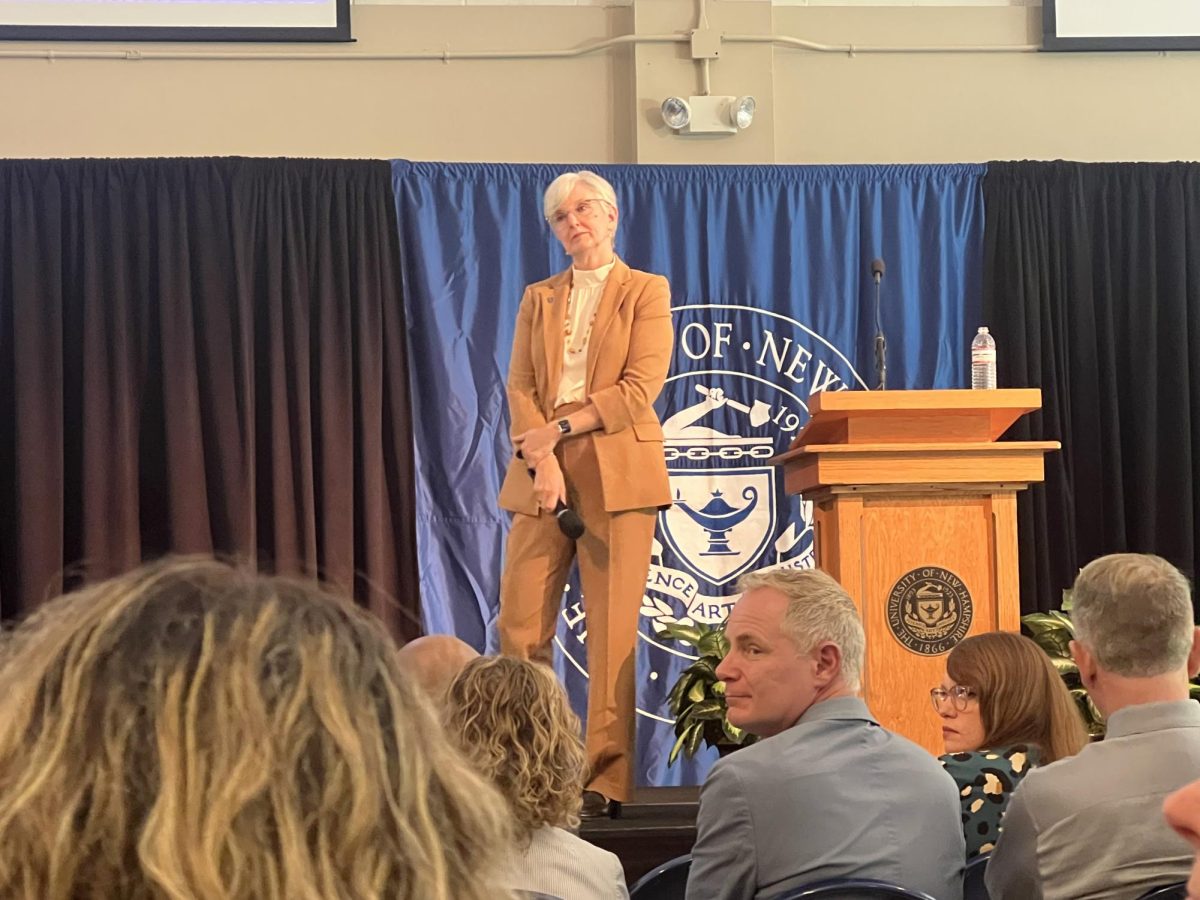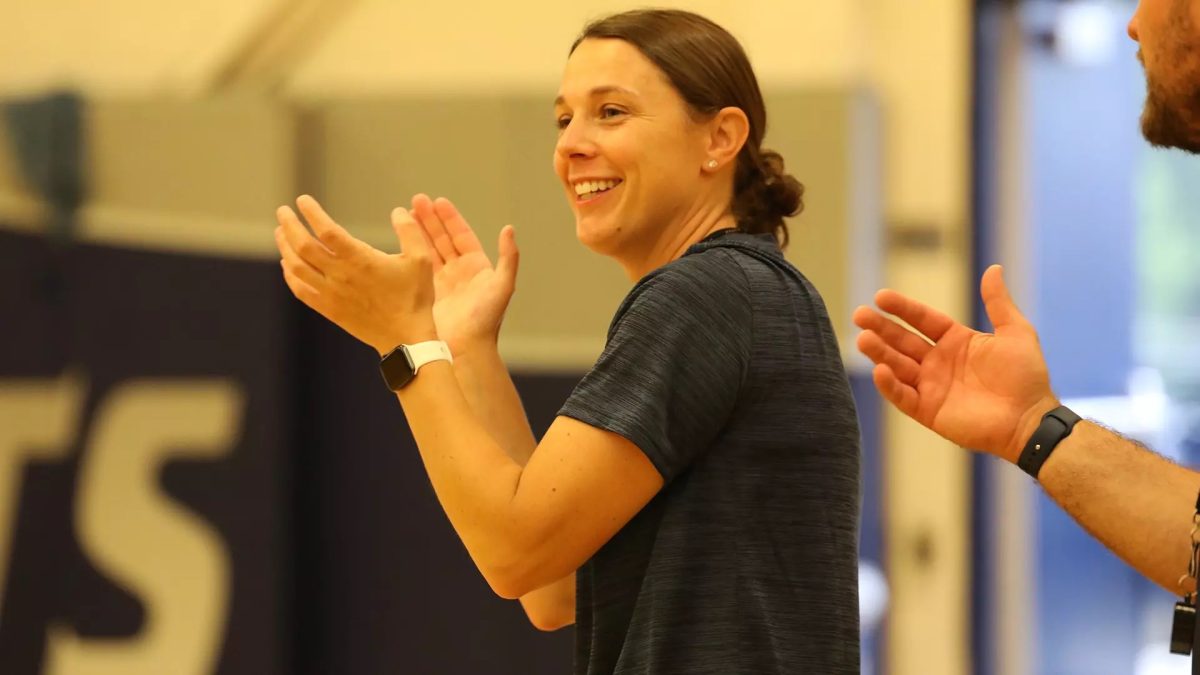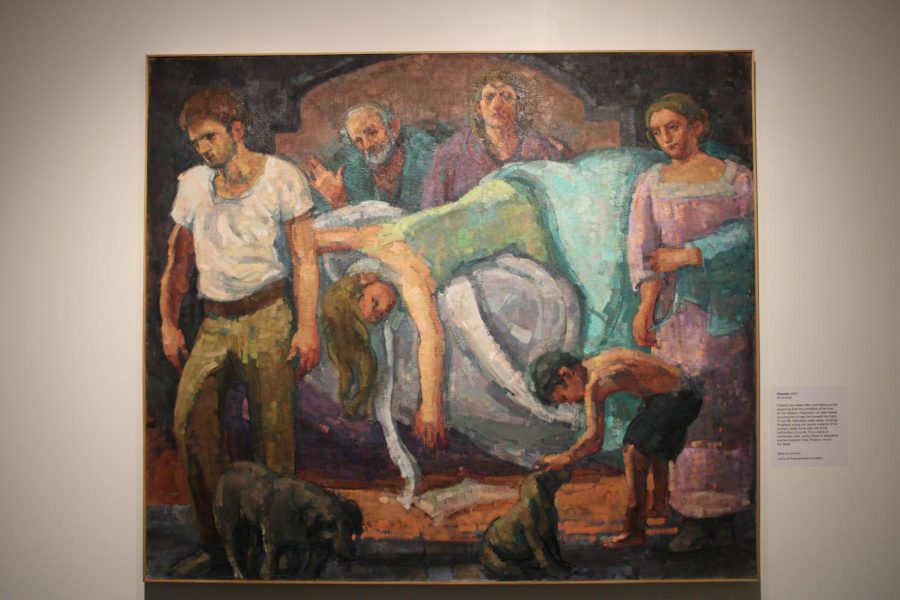UNH Museum of Art Exhibition ‘Myths Retold,’ features labels created by students of classical Greek mythology.
Mythology is portrayed within the art of Rosemarie Beck, and presented through the scholarship of UNH students.
February 27, 2023
DURHAM — The newest exhibit at University of New Hampshire’s (UNH) Museum of Art (MOA) titled “Myths Retold: Paintings by Rosemarie Beck,” features the works of Rosemarie Beck, with labels created by UNH students from Dr. Paul Robertson’s Advanced Mythology class (CLAS 601).
‘Myths Retold’ opened on Jan. 26, in the Scudder Gallery of UNH’s MOA. The paintings of late artist and teacher Rosemarie Beck line the walls.
The exhibition “Presents a collection of paintings and embroideries spanning over 40 years of the artist’s career from the mid-1970s through the early 2000s, exploring themes of gendered
relationships, power and oppression through scenes from classical Greek mythology and English literature,” as stated by the MOA.
Each of Beck’s paintings are accompanied by a white label. Each label lists the name of a student who examined Beck’s art, and their description of its mythological nuances.
“The focus of the assignment was trying to figure out how to communicate these things [mythological nuances] in a way that was understandable, because in myth you have these complex relationships going on,” said Jim Kertis. Kertis is a fourth year English major, who wrote the label for Beck’s “Phaedra (2002).”
“Phaedra” (2002), is a painting based on Euripides’ play “Hippolytus.” In the play, the character Phaedra commits suicide after being romantically rejected by her stepson, Hippolytus.
The “Phaedra” (2002), painting is “fairly traditional,” and features “classical style dress that is a lot less modernized than a lot of the other works.” Many of Rosemarie Beck’s other paintings that nod to classical mythology depict more modern attire. The nuances within “Phaedra” were more blatant, as the painting is a “pretty exact adaptation” of Euripedes’ Hippolytus, said Kertis.
Beck’s “Phaedra” (2002), depicts Phaedra on a bed. She is deceased, and holding a suicide note that accuses her stepson Hippolytus of rape. Hippolytus is pictured nearby, walking away. Phaedra’s son is pictured petting a dog.
“My favorite [mythological reference] is where you have Hippolytus turning away. It’s a good way of showing the indifference that he felt in the original work without needing to explain it in words,” said Kertis. Phaedra’s son, petting the dog “represented that he had this other calling to Artemis.”
Artemis is the Greek goddess of the hunt. She is often represented through animals.
“I’ve kind of always enjoyed art, but I’ve never really interacted with it in this type of academic context where you’re trying to interpret” and “get that interpretation out in a very short amount of space,” said Kertis.
Many of the students from the classical Greek mythology class had little experience with art and labeling museum works prior to ‘Myths Retold,’ so they “learned a new skill,” said Dr. Paul Robertson, a senior lecturer in UNH’s Classics, Humanities and Italian Studies Department.
Robertson said they learn most from students when it comes to interpretation and creativity.
“When students are reading ancient plays and then interpreting a colossal, gorgeous painting based off of that myth, they see things that I never did, they have interpretations that are insightful and different from my own, and they bring a whole wealth of their unique, subjective experience to the engagement and understanding of the art,” said Robertson.
Molly Bolick, the Education and Outreach manager of the UNH MOA, made observations about the collaboration between CLAS 601 and the Museum of Art. Bolick manages the museum’s academic and public programs. She works with students to observe, reflect and analyze pieces of art. She believes the involvement of student collaboration at the museum of art is “essential.”
“The collaboration enables students who come in for class visits to connect with works of art on an additional level,” said Bolick “When they have the labels written by fellow students right there, it enables a level of familiarity and closeness with the myths portrayed that wouldn’t otherwise be present. They can picture themselves as the authors. In the process, the stories in the myths portrayed become more familiar…more accessible.”
The ‘Myths Retold’ exhibition will be available at the MOA until April 1 . There are events leading up to the exhibits closing, including an “Art Break,” featuring the Museum of Art Fellows, CLAS 601 students and Professor Paul Robertson on March 29. This event is from 12:10-1:00p.m. and admission is free to the public.
“CLAS 601 was an amazing group. Every professor speaks of those particular classes where the students were hungry to learn, engaged, worked hard and were really positive about coming to class,” said Robertson. “It’s what makes being a professor a joy.”





















